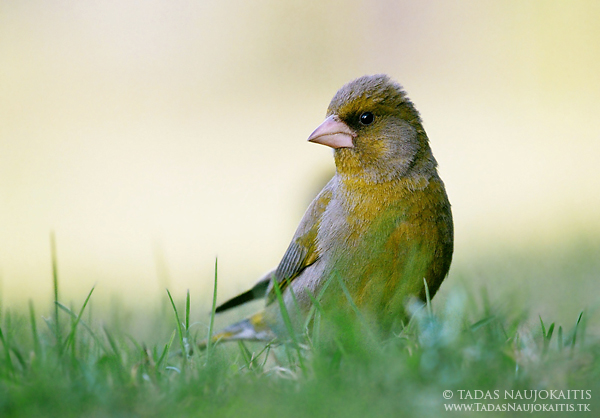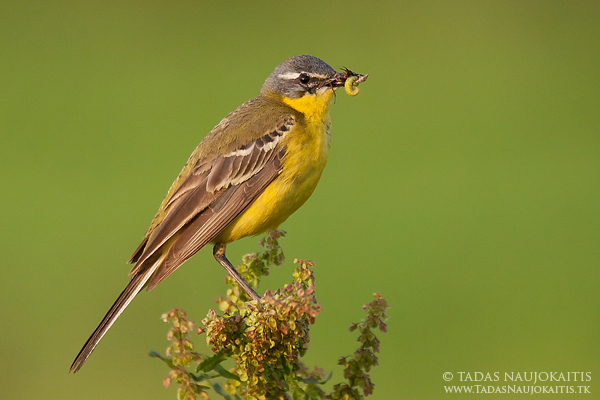Fotografare insetti
As bad as they were, those first few macro shots opened my eyes to the amazing detail and intricacies that lay just beyond the capabilities of our vision. Watching the insects move through the viewfinder was - and still is - a fascinating experience. So, from my earliest attempts, I decided I was going to only shoot live insects.
Of course, the advantage of shooting dead insects is that they hold really still for you. The downside is that - well - they're dead - and often, a keen observer can tell. You also miss out on watching the bugs in action - and sometimes capturing that action in stunning detail.
For starters, I'll walk you through the gear I am shooting with and some basic technical tips, then I'll wrap this up by sharing some ideas on working with the insects and most importantly "containment" during the shoot.
Until recently, I was shooting with a Canon 10D, but this Spring I treated myself to a "major" upgrade ... a used Canon 20D bought off ebay for $325. So, it's safe to say that just about any DSLR will be adequate for this.
Lenses
For lenses, I typically shoot with one of two set ups.
1. Extension Tubes
Canon 50mm f/1.8 (it can be bought for about $95) mounted in front of some Kenko extension tubes. The multiplier effect gained from the extension tubes allows me to count the hairs on an ant's head.

2. Reverse Lenses setup
The standard "kit lens" that came in the box with the 10D (28-105mm f/3.5-4.5) mounted in front of the extension tubes. Then, using a macro coupler ring, I mount an old Minolta 50mm f/1.7 BACKWARDS in front of the 28-105 lens.
The first time I heard about this reversed lens technique, I was sure it was voodoo. But if you think about what goes on inside a lens when you mount it correctly - it takes a large scene and reduces it down to fit on the camera's sensor. So, when you mount it backwards, the opposite is true. Tiny objects suddenly appear rather large. Add to that the multiplier effect gained from the extension tubes and suddenly, you can count the cells in a fly's eye.
I won't bore you with a lot of math, but basically, if you divide the focal length of the main lens by the focal length of the reversed lens that is the degree of magnification you are getting. So w/ a 50mm lens reversed in front of a 100mm lens, an object that measures 12 x 8mm will completely fill a 24 x 16 mm CMOS sensor. By stacking extension tubes between the main lens and the camera body the magnification factor is further increased. Now, go reverse mount that same 50mm lens in front of a 300 mm lens and you are bordering on the microscopic.

Below you can see a typical setup: Canon EOS 20D with 3 Kenko extension tubes (12mm, 20mm & 36mm), Canon 28-105mm lens and Minolta 50mm f/1.7 reverse mounted via macro coupler ring. Also depicted are 2 LumoPro 120 flashes.

But all this magnification comes at a cost
It's going to cost you three ways actually...
1. Less light hits the sensor. When I add the reversed lens, I know I've just given up 2 stops of light. For each 20mm of extension tubes I add, I give up roughly another stop. I've got a couple of standard lighting setups that produce consistently good results for me, but I'll cover those later on. For now, just know that you're going to want to get a hold of 1-2 strobes that you can adjust manually. I use LumoPro 120s from mpex.com (the new 160s are available!) These lights cost about $125 apiece and are adjustable in 1-stop increments down to 1/32 power.
2. Depth of field. Trust me, you want to ease into this. Start with a 12m extension tube, then gradually work your way up. I am regularly working with a depth of field that is less than 1mm - even at f/29. That's hard enough to deal with when your subject is inanimate - but live insects tend to be quite active. As a result, I have to shoot these things handheld. Now, I can already hear you saying, "Wait a minute, Scott! Everybody who writes about macro photography says you've got to use a sturdy tripod." If I were shooting an inanimate object, I would absolutely agree - but when your subject is running around and you've got a 1mm DOF, you learn to ditch the tripod in a hurry.
3. Forget that your camera has an auto-focus feature. Extension tube manufacturers will tell you that their tubes work with your camera's auto-focus system. While the tubes may allow the auto-focus system to communicate with the camera, there is little chance that you will actually be able to acquire focus at these close distances. In fact, I don't even use the focus ring - I switch to manual focus, set the lens to its "macro" setting and I acquire focus by moving the camera closer to or further from the subject. This is only possible because I am not bolted to a tripod.
A big disadvantage of shooting handheld is, of course, camera shake. But, welcome to the world of small off-camera flashes. Those cheap little LumoPro 120s fire at 1/30,000 of a second when they are set to 1/32 power. Even though my 20D may only syncs at 1/250 sec., the flash duration is what is exposing the scene and when you get into exposure times less than 1/5,000 sec. even a moderate hand tremor can be imperceptible.
Lighting set ups
Because of the tremendous loss of f-stops and the fact that I want my lights firing as quickly as possible to reduce the negative effects of hand holding the camera, I usually want to get my lights in fairly tight to the subject. This allows me to fire the lights at a low setting (low power = faster flash duration). But of course, there is a downside to this (there is always a downside to everything in macro photography it seems).
The downside is that if the key light is 2 inches away from the subject, and the subject scurries 3/4 of an inch away from the light, I've just lost another stop of light. So I have had to find ways to restrict the insect's movements to a small surface area, and then light that surface area as evenly as possible.
Since I typically try to shoot my insects isolated on white, I like to start out with one light coming almost straight down, but just a little bit behind the subject and angled towards the camera slightly. The second light will usually sit approximately 60° off camera axis. Both flash heads are usually within 3-5 inches of the subject area and each flash head is oriented horizontally so as to spread the beam evenly over as wide an area as possible. I usually place the insect inside a white ceramic bowl or casserole dish. Casserol dishes have the extra added benefit of having a glass lid which can come in handy when working with live insects.
Refer to the set up photo above to see how these lights are arranged.
Restricting the insect's movements
I have discovered that ants love to swim in water. Swimming in vinegar, however is not high on their list of "likes". They don't like swimming in bleach either, but I'd rather not use that if it can be avoided. So, for ants, I build a little suspension bridge out of a couple paperclips and some clear tape.

The bridge then gets placed into a bowl of vinegar. The ants will scurry all over the surface, even climbing down the paperclips to the vinegar. Most often, the ants will try to swim away once, but instead of swimming they just end up twitching a lot instead. I simply lower a tooth pick which the ant will invariably grasp gratefully, and I lift the ant back onto the bridge. Most ants don't go back for a second dip after that.

After an ant has taken a vinegar bath, it will spend a few minutes grooming itself to remove the droplets of vinegar from the antennae and legs - so be ready with the camera!
Flying insect present a whole different set of challenges. Since I do most of these shots on my kitchen counter, I clearly don't want to let dragonflies loose in the house. Even if I was working outside, I wouldn't want the insects to be flying away constantly, either. That was problematic until I ran across some information that indicated insects need the air temperature to be at least 52°F in order to achieve flight.
Shooting on the kitchen counter is one thing ... shooting inside the refrigerator is an entirely different matter, however. And I am not THAT committed. By refrigerating a flying insect for 20 minutes prior to shooting, I can usually get 2-3 minutes of shooting before the insect will exhibit signs that it is considering flight. I then recapture and stuff it back in the fridge for another few minutes.
I have also discovered that by placing the ceramic bowl inside of a larger bowl filled with ice, the ambient air temperature around the insect is much lower while I am shooting and this can greatly extend the length of time I can work with an insect before it starts thinking about taking off.
There is so much more that I would like to share, but I'm afraid this post has already gone on too long. I just want to close by encouraging you to experiment and explore.
Bird photography Tips
Equipment
It’s not necessary to have an expensive camera of lens, however the proper equipment lets to take bird photos easier.
Lens
Most birds are quite shy, so you need at least 200mm (300mm is better) to take pictures of them. Longer focal length not only lets to photograph birds from larger distance, it also gives more blurred background. However more millimeters (or larger aperture) means more expensive, larger and heavier lens. Knowing all that, I think that 400mm f/5.6 lens is the best, if you want to have as much millimeters as possible, not too small aperture and still want to be mobile. Of course, you can make magnificent bird images with 100mm or less, just you should find more courageous birds or compose them to landscape.
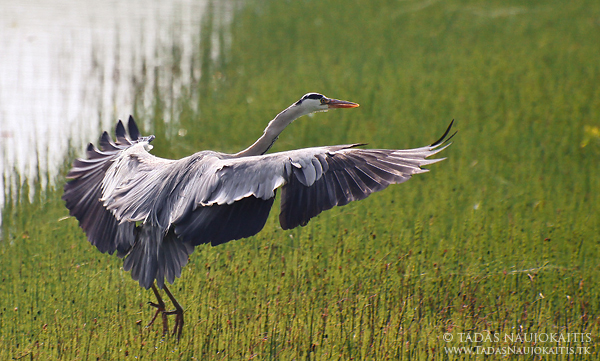
Grey Heron is landing far enough where it feels safe, but with 400mm it's possible to capture it with all the details.
Camera
In bird photography, almost all DSLR’s will make a good job. However, if you’re planning to photograph birds in flight, pay attention to fps (frames per second), high ISO results and AF (autofocus) system’s accuracy. If you don’t have a DSLR camera, then bird photography becomes a bit more difficult (especially due to slow AF), but don’t give up – a good photographer, I believe, will make better bird photos with mobile phone than a poor one with the most expensive equipment.
Tripod, monopod, flash, even remote control sometimes help much, but usually aren’t necessary.
Camera settings
It’s very important to know what settings to choose in certain situation to get most from your camera.
Exposure
In bird photography lens with long focal length are usually used, so it’s very important to set not too long exposure, if you don’t want that camera shake would cause blurry pictures. The rule is to set expose not longer than focal length of your lens. For example, if your lens focal length is 400mm, you need to set at least 1/400 exposure to get sharp images. However, it is valid only if you have a full-frame camera. If your have a DSLR with smaller sensor (e.g. APS-C DSLR – with 1.6 crop factor), you need to multiply millimeters of your lens from the crop factor. This time that would be (400 x 1.6 = 640) 1/640 exposure. If you don’t have a DSLR, you usually won’t need to multiply anything – the focal length, written on your camera lens, usually already is multiplied (actually it’s 35mm equivalent). Today, most lens or cameras have image stabilization (IS, VR…), and that helps much in low light conditions. Using it, you can set as many steps longer exposure, as you find in your lens/camera specifications, and get sharp images. For instance, if there is a 2 steps 400mm lens stabilizer, you can set 2 steps longer exposure (1/400-1/200-1/100, with APS-C camera: 1/640-1/320-1/160). When using tripod, of course, these rules to minimize camera shake are not so important.
If you want so freeze action, set 1/1000 or shorter exposure, if you would like to show movement, use 1/60 or longer.
Aperture
As you may already knew, aperture controls DOF (depth of field). That means, if you want a more blurred background, set the largest aperture (the smallest number). However, when using telephoto lens, some parts of bird’s body may appear out of focus, so pay attention where exactly you are focusing (that usually is the bird’s eye). If necessary, close aperture a bit.
ISO
In bird photography, as in anywhere else, the lower ISO speed, the better. However, it’s much better to set ISO 800 or 1600 and get a sharp picture, than ISO 200, and get the blurry one.

This photo of Black Redstart was made with ISO 2000, because there wasn't much light, and I believe it was worth it.
Some other notes
When photographing birds, three modes work the best. If you want to control aperture (depth of field), choose Av (aperture priority) mode. For shutter speed controlling (especially useful when photographing birds in flight) use Tv (shutter priority) mode. If you exactly know what settings you need, choose M (manual) mode.
If you photograph dark bird in light background or want to get more details from dark areas, set the positive exposure compensation value, if you want to avoid overexposed areas, set the negative one.
I recommend you to always shoot in RAW, if possible, because later you can easily fix such things as WB (white balance) with computer.
Ways to photograph birds
The next step is to learn, how to get to the birds closer, so then you will be able to take quality pictures of them.
So you can:
Don’t do anything exceptional
Some birds are courageous and let you to come close enough. The best example is Mute Swans.
Move carefully
Many birds let you to come close enough if you simply don’t make any sudden movements.
Stalk
Sometimes this really works, just make that bird won’t see you when you are coming closer and then, very carefully, take picture.
Lie without any movements
Birds sometimes come surprisingly close, when you lie. Just find a good place or put some food and be patient!
Hide
When photographing a shy bird or wanting a small bird to come very close for a quality photo this is the best technique. You can hide using hunting blind, camouflage net or the blind you made yourself from surrounding materials. The lower is blind, the more courageous birds feel. If you use surrounding materials to camouflage the blind or to hide yourself, that is another advantage. You can hide near various objects, which attracts birds. Also, you can put some food where you want for birds to come. Sunflower’s seeds are the best food in most cases. If you want that bird would sit on the twig or something similar before taking food, put that twig above the food.
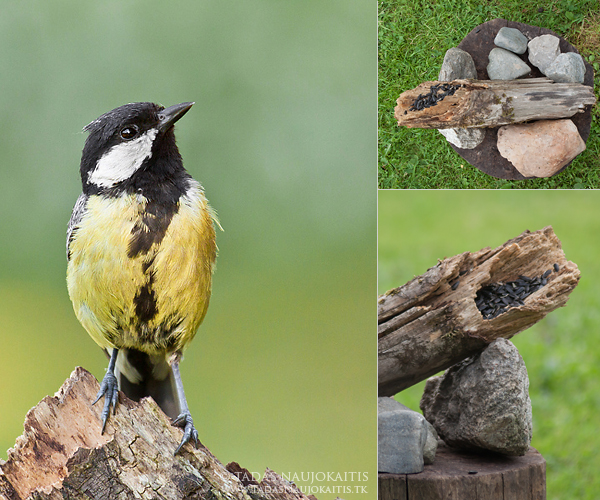
Here you can see the photo of Great Tit and how it was made.
It doesn’t matter which way you choose, be patient. Don’t wander from one bird (birds) to other (others), if you didn’t succeeded from the first time. Sometimes it’s a good idea to go back next day and try again.
The Image
Now, lets talk about the image itself. We know what equipment we need, what camera settings to choose, how to get to the bird closer, now it’s time to find out how to make the image of the bird look attractive.
The light
Everything starts with a good light. The best time for photography is morning or evening because the light is soft and has a pleasant hue, shadows are not so distinct, it’s easier to get details from very bright and dark areas.

In this example you can see that this White-winged Tern has both black and white feathers, but because it was photographed in the evening, there are no pure white or black areas.
Composition
It is usual to leave some space in the direction the bird is looking or flying. Rule of thirds sometimes helps too. Simply try some different framing to see when you get the best result. In addition, try to avoid any distracting elements, when you are taking the picture. And one more thing to mention: when you are taking the photo of the bird, try to be in it’s eye level.
The bird’s sitting place and the background
It’s the best, when the place, where the bird sits, shows bird’s natural habitat. It can be almost anything because birds live in very different habitats. The background shouldn’t be distracting and usually it looks better when it isn’t the sky (but not always!).
Capture something more
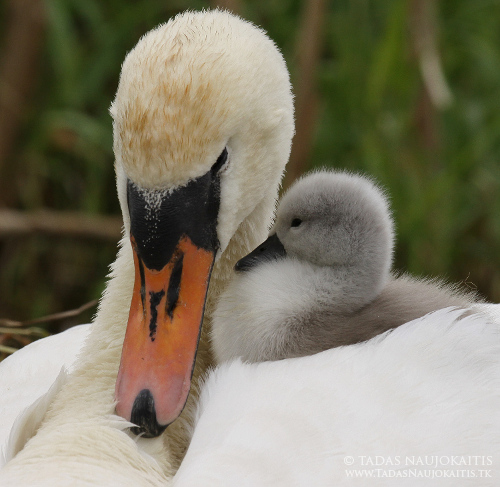
Ethics of bird photography
Birds are wonderful creatures. When you are taking photos, don’t harm them. I strongly advice you not to photograph birds near nests (except when the distance is large and bird isn’t sensitive to disturbance – there are only very few such species). Even if you don’t harm birds, you can show the place of the nest for predators. The life of bird is more important than a photo.
Conclusion
Bird photography is exciting and full of adventures. I hope after this article it will be easier for you to take beautiful bird photos.
About the Author: Tadas Naujokaitis lives in Lithuania. See more of his work at www.tadasnaujokaitis.tk and connect with him on his Facebook page.
Post by Tadas Naujokaitis from Digital Photography School - Photography Tips.
Mila’s Daydreams
Adele is a advertising copywriter from Helsinki, Finland. While her infant daughter Mila sleeps, she positions her in front of different household objects in an effort to recreate what she is dreaming. Adele titled the project, “Mila’s Daydreams.”
"This blog is my maternity leave hobby," says Adele. "While my baby is taking her nap, I create scene around her and take quick snap photos. I use only few minutes per picture, including creating idea, implementation and editing, 'cause I don't want to disturb her sleeping and most of my time is for my family."














Mila’s Daydreams blog





